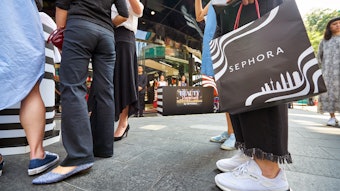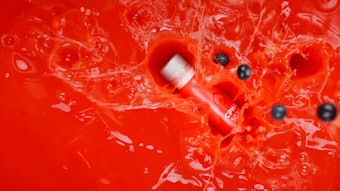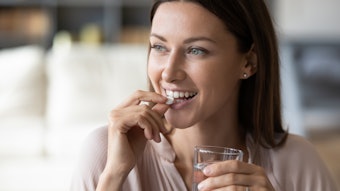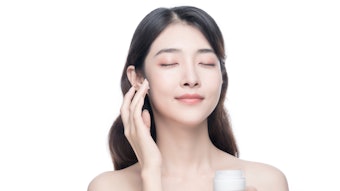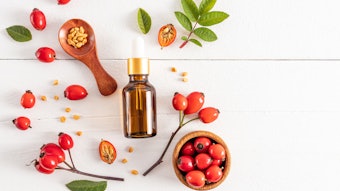Nutricosmetics are specific macro- and micronutrients that are orally delivered to help provide positive changes in the quality of the skin and general appearance. Dietary intake has clear connections with skin health and can even limit UV-induced damage.1
Macroalgae contains a number of components including micronutrients, carotenoids, fucoidan, vitamin K and omega-3 lipids that are known to provide inhibitory effects on skin damage.2
There is a well-known disparity between skin aging in Japanese women who include macroalgae in their diet compared with Causcasian women of the same age who generally do not ingest macroalgae.3 Environmental factors responsible for these differences include sun exposure and diet.
In general, fucoidan and fucoxanthin products derived from seaweed are appearing more often on the market. As whole macroalgae and its extracts gain an increased presence in the nutraceutical sector, its untapped potential for the antiaging market as a detoxifying ingredient and micronutrient provider is being realized, in addition to its use in topical cosmetic preparations. In a previous article, the authors described the historical use and current applications of macroalgae and a bioactive extract, fucoidan, as ingredients in skin care and spa products.4 In addition to its cosmetic role, macroalgae has long provided mankind with sources of food and medicine and offered certain specific benefits as nutricosmetics. This article outlines the nutricosmetic benefits of macroalgae and discusses the potential for these natural ingredients to be utilized in the development of novel formulations.
Iodine: Essential Bioactive for Health, Beauty
Macroalgae and its extracts are commonly found in food products. The Asian diet is especially rich in macroalgae based products such as the red macroalga Porphyra or nori, the brown alga Undaria or wakame, and another brown macroalga Laminaria sp. or kombu. All of these macroalgae make excellent food supplements, being nutrient and micronutrient dense, with protein yields exceeding 30% in some cases.
Iodine and other trace elements tend to be more concentrated in perennial kelps,5 for example, and protein contents are highest in edible species such as Porphyra and Ulva.2 Macroalgae also contain all the essential amino acids, omega-3 lipids and soluble fiber,2 as well as a wide variety of bioactives including lipid-modulating, blood pressure-lowering and glucose metabolism-modifying compounds.4 For instance, small peptides found in the brown macroalga Undaria pinnatifida have angiotensin-converting enzyme (ACE)-inhibitory activity, which lowers blood pressure.6
Micronutrient supplementation is essential to supporting normal healthy skin. Key micronutrients in this area include zinc, selenium and iodine. Macroalgae is a particularly rich source of iodine, and also contributes to selenium and zinc intake. Iodine is a trace element essential for synthesis of the thyroid hormones triiodothyronine and thyroxine, which affect processes and pathways mediating the intermediary metabolism of carbohydrates, lipids and proteins in almost all tissues, including skin.7
Selenium is also necessary for the formation of these important hormones. Individuals suffering from thyroid hormone deficiencies also often experience dry skin and thinning hair. Recent research has demonstrated a marked effect of topically applied thyroid hormone on hair density and epidermal proliferation in a mouse model.8
Most studies conducted on thyroid hormone tissue effects tend to concentrate on lipid metabolism. The use of iodine supplements for weight loss has been popular in both Western and Asian cultures for centuries. Eating seaweed was a popular Victorian remedy for weight loss, according to the popular Mrs. Grieves.9 In addition, there are several traditional Chinese medicines that include macroalgae, such as “concoction of the Jade flask,” which includes the brown macroalgae species Ecklonia and Sargassum and is used to treat goiter, a condition in which the thyroid gland is enlarged due to iodine deficiency.10
Today in the Western market, generally the most common use of whole macroalgae in nutraceuticals is as iodine supplements. It is important for manufacturers to consider the iodine levels in products since concentrations vary widely in the different species, from relatively low levels in Porphyra and Undaria (up to 50 micrograms/g), to extremely high levels (thousands of micrograms/g) in some kelps.5
The upper limit for intake is 300 micrograms/day and the upper limit for toxicity is 1,000 micrograms/day.11 In some countries such as Australia, iodine intake is low or marginal due to its paucity in the soil, and supplementation is probably wise.12 It is important to note that iodine-containing supplements should not be taken by persons already diagnosed with thyroid deficiencies except on the advice of their medical practitioner.
Vitamin K for Youthful Skin
Macroalgae also contains vitamins and other bioactive components. Brown, red and green macroalgae can provide vitamins A, B and C in modest dietary amounts.2 These vitamins are essential for healthy skin—for example, vitamin C is necessary for collagen production1 while the vitamin B group controls homocysteine levels.13
Vitamin K or phylloquinone is often overlooked as an essential vitamin for maintenance of elasticity and capillary integrity in skin, and recent studies have emphasized its critical role for the inhibition of elastin degradation. Vitamin K is a required coenzyme for the carboxylation of the amino acid glutamic acid in a small protein called matrix Gla protein or MGP.14
This carboxylated protein is essential in inhibiting the calcification and subsequent degradation of elastin fibers. Elastin is an elastic matrix component of vascular tissues and skin. The integrity of elastin is an important feature of youthful and healthy tissues. Degradation of elastin by proteases may also lead to the induction of inflammatory processes or so called inflamm-aging.15
Dried seaweeds have very high vitamin K content; for example, dried wakame contains 1,293 mg/100 g, as compared with broccoli, at 305 mg/100 g.16 This fat-soluble vitamin is best taken orally where the entire benefit can be realized. Thus, orally delivered dried macroalgae could make good nutricosmetic elastin support ingredients.
Carotenoids to Inhibit UV-induced Damage
The active components of macro-algae include pigments such as polyphloroglucinols and carotenoids such as fucoxanthin. Many of these have antioxidant qualities and contribute to the antioxidant nature of aqueous and nonaqueous extracts. Additionally, they are antimutagenic and protect against environmental damage.17
It has been found that UV-induced skin damage can be ameliorated by dietary means. Components that confer some protection include carotenoids, tocopherols, ascorbate, flavanoids and omega-3 fatty acids.1 Beta-carotene, lycopene, phytotene, phytofluene and lutein have all been identified in epidermal and dermal layers. They provide some protection from UV-induced skin damage, especially in combination with other antioxidants and immunoprotectives.1 Carotene, phytotene, phytofluene and lutein are all found in edible macroalgae such as Porphya, wakame and kombu. Indeed, excess intake of beta-carotene derived from the red alga Porphyra is expressed as carotenodermia, an orange color in the skin.16
However, the main antioxidant found in brown macroalgae is fucoxanthin.18 Fucoxanthin and its derivative, fucoxanthinol, have marked protective effects against inflammation in vitro, and also a profound antiobesity effect in animal models and in vitro.19, 20 This component offers significant promise as a nutricosmetic ingredient.
Glutathione, an antioxidant that is sometimes used as an orally delivered skin whitening agent, is a constituent of all macroalgae, with some species containing as much as 3,082 mg/100g.21 Additionally, omega-3 fatty acids such as stearidonic acid and hexadecatetraenoic acid are found in edible marine algae such as Undaria pinnatifida and Ulva, contributing up to 40% of the plants’ total fatty acid content.22
Enzyme Inhibition to Reduce Skin Aging
One of the major effects of UV-induced damage is increased elastase activity in the skin. Thus the inhibition of this enzyme could increase the overall elasticity of the skin when combined with the elastin-sparing activity of vitamin K. Macroalgae can provide ample activity in both these areas.
Fucoidan fractions, alginates and phloroglucinols isolated from marine algae have enzyme inhibitory properties against hyaluronidase, heparanases, phospholipase A2, tyrosine kinase and collagenase expression.23–27 Profound antiviral activity against coated viruses such as herpes and HIV is exhibited by the sulphated polysaccharides found in macroalgae.28, 29
Fucoidans are known to have substantial activity on dermal elements within in vitro models. For example, fucoidan acts to enhance dermal fibroblast proliferation and deposition of collagen and other matrix factors.30 Matrix metalloproteases that modulate connective tissue breakdown are inhibited by low molecular weight fucoidan due to increased association with its inhibitors. In addition, the serine protease leukocyte elastase was inhibited, thus protecting the elastic fiber network in human skin cultures.31 Tyrosinase is also inhibited by fucoidan fractions, indicating its potential for inclusion as whitening agents,32 an effect additional to that of glutathione.
Current Fucoidan Research
Marinova has developed a solvent-free coldwater process to extract fucoidan and is currently developing purified, organically certified extracts from a range of brown macroalgae species sourced from Tasmania, Nova Scotia, Tonga and Patagonia.
Over the last six years, the company has funded research into fucoidan, including work by Irhimeh et al., that has demonstrated a low but significant serum uptake of a high molecular weight Undaria derived fucoidan using a novel antibody technique.33 This finding was important since it confirmed that systemic effects can be attributed to serum uptake, even from a high molecular weight fucoidan.
Irhimeh et al. also demonstrated a profound increase in the sticky receptor CXCR4 on blood stem cells, attributed to the fucoidan extract. This increase was accompanied by healthy changes in cholesterol levels and an increase in the immune regulating cytokine interferon gamma.34 The significant effects of orally ingested fucoidan suggest potential for rejuvenation nutraceuticals, designed to give the body a boost of immune function.
The company is now carrying out a long term project to determine the effects of macrolgal fractions on matrix enzyme (elastase) activity and glycation, with a particular focus on cosmetics and nutricosmetics.
Glycation is one of the determinants of skin aging. High or irregular blood glucose levels and high insulin levels all correlate with higher levels of glycation. Matrix and serum protein components are gradually glycated in a nonenzymatic process—similar to the browning process that takes place during cooking. The end products of the glycation process are known as advanced glycation end products or AGEs.
In a previous report,4 data was discussed on fucoidan extracts with alpha-glucosidase activity. The action of alpha-glucosidase inhibitors is to delay carbohydrate absorption, reducing the postprandial increase in blood glucose.35 Undaria and Fucus vesiculosus fucoidans were found to be particularly efficacious since they inhibited the activity of alpha-glucosidase by 50% at a concentration of less than 20 µg/mL, in comparison with luteolin that inhibited alpha-glucosidase activity at approximately 18 µg/mL.
In the previous report,4 researchers hypothesized that this inhibitory action on alpha-glucosidase would be reflected in reduced insulin levels in serum. In data reported here, the authors investigated insulin levels as a determinant of glucose control and thus potential for glycation.
Methodology
Insulin levels in volunteer blood samples were quantitatively measured using insulin kits and an insulin analyzera. The sole restriction was that volunteers were not to have ingested seafood.
This method is a solid-phase, two-site chemiluminescent immunometric assay. The reference fasting range used for the study is 6-27 µIU/L. The insulin levels were tested in a group of volunteers(n = 10) after receiving the active treatment of 75% Undaria fucoidan, 3 g/day, divided into three one-gram doses, for a total of 12 days. The insulin was tested only at two points: baseline and 12 days from receiving the active treatment. Another group of volunteers (n = 3) who received the placebo-control treatment was also tested for insulin levels at the same test points (see Figure 1).
Results
No change in the average insulin level was found in the placebo group and only a slight decrease was found in the average insulin level of the active treatment group. The slight decrease in insulin levels, however, does suggest that fucoidan extract could act as an inhibitor of glycosidase and reduced glucose loads; yet, this trial was not sufficiently powered to achieve a statistically significant result in healthy adults.
The nutricosmetic area is still modest and relatively underdeveloped. While various fish collagen-based preparations including some vitamin blends have been around for a while, overall there is a much smaller market presence. Further research is definitely warranted.
Anti-inflammatory Fucoidans
Fucoidan is a well-known anti-inflammatory agent with potential for inclusion in nutricosmetics with an antiaging or sunscreen focus. Marinova is currently in clinical trials in this area to investigate the immunomodulatory and anti-inflammatory properties of fucoidans of interest for nutriceutical and nutricosmetic developers. These trials aim to underline the relevance of fucoidans as anti-inflammatory and antiaging ingredients. The trials are being managed and designed by professor Stephen Myers, founding director of the Australian Centre for Complimentary Medicine Education and Research and one of Australia’s leading alternative medicine researchers and practitioners.
As explained in the previous article,6 fucoidans can be considered to be a dietary fiber and are nontoxic in cell culture. No toxicological changes were observed in rats administered up to 300 mg/kg of fucoidan from Laminaria japonica orally. Anticoagulant effects were observed at doses of 900 to 2,500 mg/kg, but no other signs of toxicity were observed.36 Marinova has also undertaken a safety trial in cancer patients in Australia and demonstrated that ingestion of up to 6 g per day of fucoidan has no observable side effects. This study is currently unpublished.
Conclusion
Macroalgae and its extracts are novel nutricosmetic ingredients that can provide cosmetic antiaging benefits such as inhibition of matrix enzymes, glycation inhibition and anti-inflammatory activity, in addition to inhibition of elastin calcification. While macroalgae remain a staple of the spa industry, fucoidan-rich macroalgal extracts have strong potential for commercial success in cosmetics. Key components include fucoidan, vitamin K, minerals and trace elements and carotenoids.
From a consumer’s point of view, it tends to take longer to generate beneficial effects on skin through oral supplements, although the effects may be longer-lasting. It is more difficult to market a product that requires persistence and this may account for limited research currently in the nutricosmetics area. Combination products offering two levels of effect—topical, more immediate effects, plus orally administered, longer-term effects—may make more of an impact on consumers.
The nutraceutical world generally does not focus on taking skin measurements as part of clinical studies on supplements, although some supplements likely generate benefits for the skin. As the market matures, the industry may see more of a focus on the health of skin via nutrition.
References
1. H Sies and W Stahl, Nutritional protection against skin damage from sunlight, Annu Rev Nutr 173–200 (2004)
2. S Aaronson, Algae, in The Cambridge World History of Food, K Kiple and KC Ornelas, eds, Cambridge University Press, Cambridge, UK, Vol I, Ch. II.C.I 231–249 (2000)
3. K Tsukahara et al, Comparison of age-related changes in wrinkling and sagging of the skin in Caucasian females and in Japanese females, J Cosmet Sci 55(4) 351–71 (Jul/Aug 2004)
4. JH Fitton, M Irhimeh and N Falk, Macroalgal fucoidan extracts: A new opportunity for marine cosmetics, Cosm & Toil 122, 55–64 (2007)
5. J Teas, S Pino, A Critchley and LE Braverman, Variability of iodine content in common commercially available edible seaweeds, Thyroid 14, 836 (2004)
6. K Suetsuna and T Nakano, Identification of an antihypertensive peptide from peptic digest of wakame (Undaria pinnatifida), J Nutr Biochem 11(9) 450–4 (Sep 2000)
7. M Moreno, P de Lange, A Lombardi, E Silvestri, A Lanni and F Goglia, Metabolic effects of thyroid hormone derivatives, Thyroid 18(2) 239–53 (Feb 2008)
8. JD Safer et al, Thyroid hormone action on skin: Diverging effects of topical versus intraperitoneal administration, Thyroid 13(2) 159–65 (Feb 2003)
9. M Grieve, A Modern Herbal, Dover Publications Inc., New York (1971)
10. C Tseng, Algal biotechnology industries and research activities in China, J Appl Phycol 13, 375 (2001)
11. European Commission Web site, Safe upper intake levels for vitamins and minerals, available at: http://ec.europa.eu/food/food/labellingnutrition/supplements/documents/denmark_annex2.pdf (Accessed Mar 28, 2008)
12. M Li et al, Are Australian children iodine deficient? Results of the Australian National Iodine Nutrition Study, Med J Aust 184(4) 165–9 (Feb 20, 2006)
13. P Gisondi, F Fantuzzi, M Malerba and G Girolomoni, Folic acid in general medicine and dermatology, J Dermatolog Treat 18(3) 138–46 (2007)
14. D Gheduzzi et al, Matrix Gla protein is involved in elastic fiber calcification in the dermis of Pseudoxanthoma elasticum patients, Lab Invest 87(10) 998–1008 (Oct 2007)
15. F Antonicelli, G Bellon, L Debelle and W Hornebeck, Elastin-elastases and inflamm-aging, Curr Top Dev Biol 79 99–155 (2007)
16. M Kamao et al, Vitamin K content of foods and dietary vitamin K intake in Japanese young women, J Nutr Sci Vitaminol (Tokyo) 53(6) 464–70 (Dec 2008)
17. Y Okai, K Higashi-Okai, Y Yano and S Otani, Identification of antimutagenic substances in an extract of edible red alga, Porphyra tenera (Asakusa-nori), Cancer Lett 100(1-2) 235–40 (Feb 27, 1996)
18. Y Nishimura, N Ishii, Y Sugita and H Nakajima, A case of carotenodermia caused by a diet of the dried seaweed called Nori, J Dermatol 25(10) 685–7 (Oct 1998)
19. X Yan et al, Fucoxanthin as the major antioxidant in Hijikia fusiformis, a common edible seaweed, Biosci Biotechnol Biochem 63(3) 605–607 (1999)
20. H Maeda et al, Fucoxanthin from edible seaweed, Undaria pinnatifida, shows antiobesity effect through UCP1 expression in white adipose tissues, Biochemical and Biophysical Research Communications 332, 392–397 (2005)
21. H Maeda, M Hosokawa, T Sashima, N Takahashi, T Kawada and K Miyashita, Fucoxanthin and its metabolite, fucoxanthinol, suppress adipocyte differentiation in 3T3-L1 cells, Int J Mol Med 18(1)147–52 (Jul 2006)
22. M Kakinuma, CS Park and H Amano, Distribution of free L cysteine and glutathione in seaweeds, Fisheries Science 67, 194 (2001)
23. T Katsube, Y Yamasaki, M Iwamoto and S Oka, Hyaluronidase-inhibiting polysaccharide isolated and purified from hot water extract of Sporophyll of Undaria pinnatifida, Food Sci Technol Res 9, 25 (2003)
24. CR Parish, DR Coombe, KB Jakobsen, FA Bennett and PA Underwood, Evidence that sulphated polysaccharides inhibit tumour metastasis by blocking tumour cell derived heparanases, Int J Cancer 40, 511 (1987)
25. T Shibata, K Nagayama, R Tanaka, K Yamaguchi and T Nakamura, Inhibitory effects of brown algal phlorotannins on secretory phospholipase A2s, lipoxygenases and cyclooxygenases, J Appl Phycol 15, 61 (2003)
26. M Wessels, G Konig and A Wright, A new tyrosine kinase inhibitor from the marine brown alga Stypopodim zonale, J Nat Prod 62, 927 (1999)
27. MJ Joe et al, The inhibitory effects of eckol and dieckol from Ecklonia stolonifera on the expression of matrix metalloproteinase-1 in human dermal fibroblasts, Biol Pharm Bull 29(8) 1735–9 (Aug 2006)
28. DJ Schaeffer and VS Krylov, Anti-HIV activity of extracts and compounds from algae and cyanobacteria, Ecotoxicology and Environmental Safety 45, 208 (2000)
29. KD Thompson and C Dragar, Antiviral activity of Undaria pinnatifida against herpes simplex virus, Phytother Res 18, 551 (2004)
30. R O’Leary et al, Fucoidan modulates the effect of transforming growth factor (TGF) - ß1 on fibroblast proliferation and wound repopulation in in vitro models of dermal wound repair, Biol Pharm Bull 27(2) 266–270 (2004)
31. K Senni et al, Fucoidan, a sulfated polysaccharide from brown algae, is a potent modulator of connective tissue proteolysis, Arch Biochem Biophys 1 445(1) 56–64 (Jan 2006)
32. XJ Kang, FX Wang, CM Sheng and Y Zhu, Undaria pinnatifida stem fucoidan biological activity of the composition and bioactivity, Chinese Pharmaceutical Journal 41(22) 1748-1750 (2006)
33. MR Irhimeh, JH Fitton, RM Lowenthal and
P Kongtawelert, A quantitative method to detect fucoidan in human plasma using a novel antibody, Methods Find Exp Clin Pharmacol 27(10) 705–710 (Dec 2005)
34. MR Irhimeh, JH Fitton and RM Lowenthal, Fucoidan ingestion increases the expression of CXCR4 on human CD34+cells, Exp Hematol (2007) (in press)
35. HP Rang, MM Dale and JM Ritter, Pharmacology, 3rd edn. Churchill Livingstone, New York (1995)
36. N Li, Q Zhang and J Song, Toxicological evaluation of fucoidan extracted from Laminaria japonica in Wistar rats, Food Chem Toxicol, 43 421 (2005)

